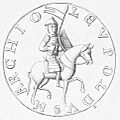Leopold III, Margrave of Austria facts for kids
Quick facts for kids SaintLeopold III |
|
|---|---|

Saint Leopold III with two deceased sons, Babenberger Stammbaum, Klosterneuburg Monastery, 1489–1492
|
|
| Margrave of Austria | |
| Born | 1073 Babenberg Castle, Gars am Kamp, Lower Austria |
| Died | 15 November 1136 Klosterneuburg Monastery, Lower Austria (incl. burial) |
| Venerated in | Roman Catholic Church |
| Canonized | 6 January 1485 by Pope Innocent VIII |
| Feast | 15 November |
| Attributes | Model of church |
| Patronage | Austria, lower Austria, upper Austria, Vienna, death of children, large families, step-parents |
|
Leopold III
|
|
|---|---|
| Margrave of Austria | |
| Margrave | 1095–1136 |
| Predecessor | Leopold II |
| Successor | Leopold IV |
| Family | House of Babenberg |
| Spouse | Agnes of Germany |
| Issue |
|
| Father | Leopold II |
| Mother | Ida of Formbach-Ratelnberg |
Leopold III (born in 1073, died November 15, 1136) was an important ruler of Austria. He was known as Leopold the Good. From 1095 until his death, he was the Margrave of Austria. A margrave was a type of ruler, similar to a duke or count, who governed a border region. Leopold belonged to the powerful House of Babenberg family. He was later made a saint on January 6, 1485. Today, he is the patron saint of Austria and its capital city, Vienna. People celebrate his special day on November 15.
Contents
Life of Leopold III
Early Life and Family
Leopold was born in 1073 at Babenberg Castle in Gars am Kamp. His father was Margrave Leopold II. His family, the Babenbergs, became very important in Austria. They had moved there from Bavaria in the 900s. Leopold grew up learning from a wise bishop named Altmann of Passau.
Becoming Margrave and Marriages
In 1096, Leopold became the Margrave of Austria. He was 23 years old when he took over from his father. Leopold married twice during his life. His first wife passed away in 1105.
The next year, he married Agnes. She was the widowed sister of Emperor Henry V. This marriage was very important for Leopold's family. It helped the House of Babenberg gain more power and influence. Agnes also had important connections from her first marriage. Her son from that marriage was Conrad III of Germany, who later became a German king.
A Wise Ruler
Leopold called himself "Princeps Terræ," which means "Prince of the Land." This showed that he felt Austria was an independent territory. He was even considered to become the Kaiser (Emperor) of the Holy Roman Empire in 1125. However, he chose not to take on this great honor.
Leopold is best remembered for helping Austria grow and develop. He especially focused on building new monasteries. Monasteries were important religious centers where monks lived and worked.
Founding Monasteries and Cities
His most famous project was the founding of Klosterneuburg in 1108. A legend says that the Virgin Mary appeared to him there. She led him to a spot where he found his wife Agnes's veil, which she had lost years before. Leopold then built the Klosterneuburg Monastery on that very spot. He later made Klosterneuburg his main home.
Leopold also founded other important monasteries. These included Heiligenkreuz, Kleinmariazell, and Seitenstetten. These monasteries helped develop areas that were mostly forests at the time. Because of his great work for the church, Leopold was made a saint in 1485.
He also helped cities like Klosterneuburg, Vienna, and Krems grow. Krems was even given the right to mint its own coins.
During Leopold's time, the first literary texts from Austria were written. These were by Henry of Melk and Ava of Göttweig. Leopold was buried in the Klosterneuburg Monastery that he founded.
Legacy and Patronage
In 1663, Emperor Leopold I declared Saint Leopold III the new patron saint of Austria. Before this, Coloman of Stockerau held that title.
Famous composers Joseph and Michael Haydn both sang in the choir at Klosterneuburg. Michael Haydn later wrote a special mass to honor Saint Leopold. It was called the Missa sub titulo Sancti Leopoldi.
Since the death of Emperor Leopold I, a special day called the King's Feast is celebrated in Belgium on Saint Leopold's feast day.
Leopold's Children
Leopold's first marriage did not result in any children.
With his second wife, Agnes of Germany, who was the widow of Frederick I, Duke of Swabia, Leopold had many children:
- Adalbert
- Henry II Jasomirgott (1107–1177)
- Leopold IV (around 1108 – 1141)
- Berta, who married Henry III
- Agnes (around 1108–1163), who married Władysław II of Poland
- Ernst
- Uta
- Otto of Freising (around 1114 – 1158), who became a bishop and wrote about his nephew, Emperor Frederick I Barbarossa
- Conrad, who became a bishop and later an archbishop
- Elisabeth, who married Hermann II of Winzenburg
- Judith, who married William V of Montferrat
- Gertrude, who married Duke (later King) Vladislaus II of Bohemia
Some historical writings suggest that there might have been up to seven other children. These children may have been stillborn or died very young. Recent DNA tests have also supported that Adalbert was indeed a son of Leopold and Agnes.
Images for kids
-
Saint Leopold Altar, Stephansdom
See also
- List of rulers of Austria





